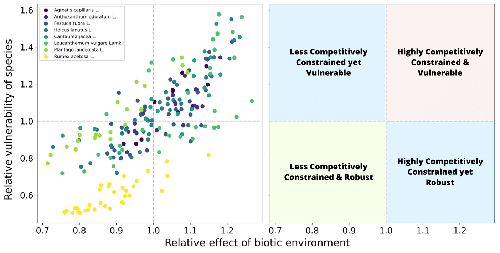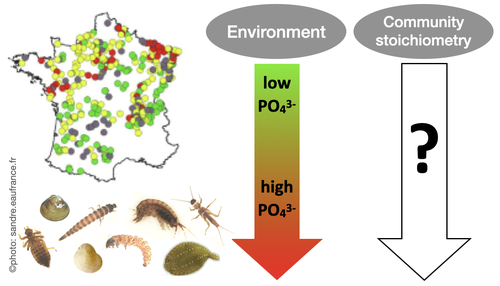
GUILLEMAUD Thomas
- Institut Sophia Agrobiotech, Inra, sophia Antipolis, France
- Ecosystem functioning
- administrator, recommender, manager
Recommendations: 0
Reviews: 5
Reviews: 5
Habitat structural complexity increases age-class coexistence and population growth rate through relaxed cannibalism in a freshwater fish
Habitat complexity reduces cannibalism, enhancing population-level diversity and productivity in a freshwater fish
Recommended by Matthew Bracken based on reviews by Thomas Guillemaud, Joacim Näslund and 2 anonymous reviewersHabitat complexity is an important mediator of processes spanning levels of biological organization from organisms to ecosystems (Shumway et al. 2007, Soukup et al. 2022). This complexity, which can be biogenic (e.g., foundation species; Bracken et al. 2007, Ellison 2019) or abiotic (e.g., substrate rugosity; Kovalenko et al. 2012), shapes processes ranging from individual foraging behavior (Michel and Adams 2009) to species’ interactions to food-web structure and biogeochemical rates (Langellotto and Denno 2006, Larsen et al. 2021, Soukup et al. 2022). For example, in the presence of simulated aquatic vegetation, predatory diving beetle larvae shift from active foraging to sit-and-wait predation, reducing activity and prey encounter rates (Michel and Adams 2009).
In this contribution, Edeline et al. (2023) present a detailed perspective on the role of habitat complexity in shaping populations of a freshwater fish (medaka, Oryzias latipes, Adrianichthyidae), including survival, age-class diversity, population growth rate, and density-dependence in the stock-recruitment relationship associated with changes in carrying capacity. Importantly, changes in these population demographic attributes and rates were associated with the role of habitat complexity in mitigating cannibalism – consumption of juvenile O. latipes by conspecific adults. Whereas this is not unexpected – Langelotto and Denno (2006) showed that habitat complexity reduces cannibalism in wolf spiders – the careful work of Edeline et al. (2023) to link changes in habitat complexity to multiple population-level attributes provides a uniquely detailed description of the role of submerged aquatic vegetation in mediating population diversity (e.g., higher age-class diversity) and productivity (e.g., population growth rate).
In many ways, this work by Edeline et al. (2023) provides population-level parallels to perspectives on the role of habitat complexity in determining community-level diversity and productivity. Structurally complex habitats, such as those provided by foundation species (Bracken et al. 2007, Ellison 2019) and substrate heterogeneity (Fairchild et al. 2024), are associated with higher species diversity and abundance at the community level. Edeline et al. (2023) extend these perspectives to the population level, highlighting the importance of habitat complexity across levels of biological organization. Their work highlights within-population diversity and interactions, including cannibalism and competition, illustrating often-neglected aspects of food-web complexity (Polis and Strong 1996).
References
Matthew E. S. Bracken, Barry E. Bracken, Laura Rogers-Bennett (2007) Species diversity and foundation species: potential indicators of fisheries yields and marine ecosystem functioning. California Cooperative Oceanic Fisheries Investigations Reports 48: 82-91. https://calcofi.org/downloads/publications/calcofireports/v48/Vol_48_Bracken.pdf
Eric Edeline, Yoann Bennevault, David Rozen-Rechels (2023) Habitat structural complexity increases age-class coexistence and population growth rate through relaxed cannibalism in a freshwater fish. bioRxiv, ver.4 peer-reviewed and recommended by PCI Ecology https://www.biorxiv.org/content/10.1101/2023.07.18.549540v4
Aaron M. Ellison (2019) Foundation species, non-trophic interactions, and the value of being common. iScience 13: 254-68. https://doi.org/10.1016/j.isci.2019.02.020
Tom P. Fairchild, Bettina Walter, Joshua J. Mutter, John N. Griffin. (2024) Topographic heterogeneity triggers complementary cascades that enhance ecosystem multifunctionality. Ecology 105: e4434. https://doi.org/10.1002/ecy.4434
Katya E. Kovalenko, Sidinei M. Thomaz, Danielle M. Warfe (2012) Habitat complexity: approaches and future directions. Hydrobiologia 685: 1-17. https://doi.org/10.1007/s10750-011-0974-z
Gail A. Langellotto, Robert F. Denno. (2006) Refuge from cannibalism in complex-structured habitats: implications for the accumulation of invertebrate predators. Ecological Entomology 31: 575-81. https://doi.org/10.1111/j.1365-2311.2006.00816.x
Annegret Larsen, Joshua R. Larsen, Stuart N. Lane (2021) Dam builders and their works: beaver influences on the structure and Function of river corridor hydrology, geomorphology, biogeochemistry and ecosystems. Earth-Science Reviews 218: 103623. https://doi.org/10.1016/j.earscirev.2021.103623
Matt J. Michel, Melinda M. Adams. (2009) Differential effects of structural complexity on predator foraging behavior. Behavioral Ecology: 313-17. https://doi.org/10.1093/beheco/arp005
Gary A. Polis, Donald R. Strong (1996) Food web complexity and community dynamics. American Naturalist 147: 813-46. https://doi.org/10.1086/285880
Caroly A. Shumway, Hans A. Hofmann, Adam P. Dobberfuhl (2007) Quantifying habitat complexity in aquatic ecosystems. Freshwater Biology 52: 1065-76. https://doi.org/10.1111/j.1365-2427.2007.01754.x.
Pavel R. Soukup, Joacim Näslund, Johan Höjesjö, David S. Boukal (2022) From individuals to communities: habitat complexity affects all levels of organization in aquatic environments. Wiley Interdisciplinary Reviews: Water 9: e1575. https://doi.org/10.1002/wat2.1575
Long-term survey of intertidal rocky shore macrobenthic community metabolism and structure after primary succession
10 years of primary succession in intertidal communities: specific and functional changes
Recommended by Gudrun Bornette based on reviews by Thomas Guillemaud and John GriffinThis very interesting article describes the changes taking place on artificial substrates placed in an intertidal zone. The study presents an ambitious data set and demonstrates the importance of long-term monitoring to identify community dynamics. In summary, in the short term, the authors observe a phase of complexification of the communities and a peak in productivity, but after a few years, the macro-algae disappear in favour of limpets, a situation that persists after 10 years of monitoring. Monitoring over the short term would lead to an erroneous analysis of the succession patterns and dynamics of the communities, which has important consequences in terms of the recolonisation of artificial substrates in the marine environment.
References
Aline Migné, François Bordeyne, Dominique Davoult (2023) Long-term survey of intertidal rocky shore macrobenthic community metabolism and structure after primary succession. HAL, ver.2 peer-reviewed and recommended by PCI Ecology https://hal.science/hal-04347756

From fear to food: predation risk shapes deer behaviour, their resources and forest vegetation
A multidimensional exploration of predator-prey dynamics
Recommended by Gloriana Chaverri based on reviews by Thomas Guillemaud and 2 anonymous reviewersIn the preprint "From Fear to Food: Predation Risk Shapes Deer Behaviour, Their Resources, and Forest Vegetation", Martin et al. provide a comprehensive examination of the intricate interplay between predation risk, deer behavior, and forest ecosystems. The study offers notable insights into the "ecology of fear," as it takes advantage of an extensive dataset that reflects decades of dedicated research effort. The authors’ approach combines behavioral ecology, plant community analysis, and stable isotope studies, making this work a significant contribution to our understanding of complex ecological phenomena.
One of the most striking aspects of this study is the scale and richness of the dataset. The authors used data collected over multiple decades, spanning various experimental contexts, including islands with and without predators, hunting, and culling histories. These datasets are invaluable, as such long-term, geographically diverse studies are rare. The inclusion of both behavioral observations (e.g., flight initiation distances) and ecological outcomes (e.g., vegetation recovery) underscores the effort to provide a holistic understanding of these ecological interactions.
The results are not only scientifically robust but also conceptually significant. They challenge simplistic assumptions about predator-prey relationships by illustrating how both the presence and absence of predation risk can have lasting effects on ecosystems. For example, the findings that culling restores vegetation but creates behavioral shifts in deer populations emphasize the complexity of ecological restoration efforts. These results invite further exploration into how behavioral adaptations to predation risk may alter long-term ecosystem trajectories.
In conclusion, Martin et al.'s preprint represents a significant advancement in understanding predator-prey interactions and their cascading effects on ecosystems. The study’s comprehensive dataset and integrative approach provide a model for future research in ecological and behavioral sciences. It is a commendable contribution to the field, with implications for both theoretical ecology and practical conservation.
References
Jean-Louis Martin, Simon Chamaillé-Jammes, Anne Salomon, Devana Veronica Gomez Pourroy, Mathilde Schlaeflin, Soizic Le Saout, Annick Lucas, Ilham Bentaleb, Simon Chollet, Jake Pattison, Soline Martin-Blangy , Anthony J. Gaston (2024) From fear to food: predation risk shapes deer behaviour, their resources and forest vegetation . HAL, ver.6 peer-reviewed and recommended by PCI Ecology https://hal.science/hal-04381108v5

The distribution of distances to the edge of species coexistence
How environmental perturbations affect coexistence
Recommended by Frederik De Laender based on reviews by Thomas Guillemaud, Oscar Godoy, Pablo Lechon and 1 anonymous reviewer Understanding the effects of environmental perturbations on coexistence is a key challenge in ecology, and models have played an important role in structuring our ideas and generating predictions, leading to quantitative hypotheses. In such models, environmental perturbations are often captured by changes in parameter values, such as the intrinsic growth rates of species (1–3). The question then becomes how much one can change these parameters without breaking coexistence and thus losing species (4).
An intuitively appealing approach to address this question is to calculate a model’s feasibility domain (5–7). Loosely defined, it is the fraction of parameter settings leading to the coexistence of all species. Mathematically speaking, it is a high-dimensional triangle, of which one can calculate the size, just as for plain two-dimensional triangles. Parameter settings outside of this triangle break coexistence. Thus, it seems logical that greater feasibility domains would make for more robust ecosystems. However, careful interpretation is key: a greater feasibility domain merely implies that across many attempts at running a model with different random parameter settings, coexistence will be more frequent. It does not necessarily inform us how much one can perturb the parameters of a community with a predefined parameter setting. To get this information, we also need to know the shape of the triangle (7): perturbations more easily knock the parameter setting out of a flat triangle than out of an equilateral triangle.
Desaillais et al. (8) develop a new theory that sheds light on what drives the shape of the feasibility domain. Specifically, they present the probability distribution that tells how close to the edge of the feasibility domain the parameter settings in that domain tend to be. For example, all points in a very flat triangle are close to its edge, while in an equilateral triangle, most points are safely stowed inside. The results show how, in a Lotka-Volterra model, the matrix of species interactions fully defines this distribution, which makes the technique empirically applicable in so far as one can estimate these interactions. The analysis then continues to explore the role of specific species in putative loss of coexistence. Desaillais et al. identify two species-level quantities: the first measures the total influence of the surrounding community on a focal species, while the second is a proxy for how close that focal species is to being lost, should a perturbation occur. While these two quantities are not mathematically independent, their correlation is not perfect, allowing one to categorize species into distinct ecological roles. A dataset of plant communities with different compositions illustrates how to apply this idea and gain some additional insight into the robustness of coexistence. These results pave the way for a number of potentially rewarding applications. How does the robustness of coexistence differ across network types? For which network types do we find back a more diverse set of ecological roles for species, i.e. for which networks are the two quantities least correlated?
References
1. Baert, J.M., Janssen, C.R., Sabbe, K., and De Laender, F. (2016). Per capita interactions and stress tolerance drive stress-induced changes in biodiversity effects on ecosystem functions. Nat. Commun. 7, 12486. https://doi.org/10.1038/ncomms12486
2. Pásztor, L., Botta-Dukat, Z., Magyar, G., Czaran, T., and Meszéna, G. (2016). Theory-based ecology: A Darwinian approach 1st ed. (Oxford University Press).
3. Cenci, S., Montero-Castaño, A., and Saavedra, S. (2018). Estimating the effect of the reorganization of interactions on the adaptability of species to changing environments. J. Theor. Biol. 437, 115–125. https://doi.org/10.1016/j.jtbi.2017.10.016
4. Spaak, J.W., Baert, J.M., Baird, D.J., Eisenhauer, N., Maltby, L., Pomati, F., Radchuk, V., Rohr, J.R., Van den Brink, P.J., and De Laender, F. (2017). Shifts of community composition and population density substantially affect ecosystem function despite invariant richness. Ecol. Lett. 20, 1315–1324. https://doi.org/10.1111/ele.12828
5. Meszéna, G., Gyllenberg, M., Pásztor, L., and Metz, J.A.J. (2006). Competitive exclusion and limiting similarity: A unified theory. Theor. Popul. Biol. 69, 68–87. https://doi.org/10.1016/j.tpb.2005.07.001
6. Saavedra, S., Rohr, R.P., Bascompte, J., Godoy, O., Kraft, N.J.B., and Levine, J.M. (2017). A structural approach for understanding multispecies coexistence. Ecol. Monogr. 87, 470–486. https://doi.org/10.1002/ecm.1263
7. Grilli, J., Adorisio, M., Suweis, S., Barabás, G., Banavar, J.R., Allesina, S., and Maritan, A. (2017). Feasibility and coexistence of large ecological communities. Nat. Commun. 8. https://doi.org/10.1038/ncomms14389
8. Desallais M, Loreau M, Arnoldi J.F. (2024) The distribution of distances to the edge of species coexistence. bioRxiv, ver.4 peer-reviewed and recommended by PCI Ecology https://doi.org/10.1101/2024.01.21.575550

Effects of water nutrient concentrations on stream macroinvertebrate community stoichiometry: a large-scale study
The influence of water phosphorus and nitrogen loads on stream macroinvertebrate community stoichiometry
Recommended by Huihuang Chen based on reviews by Thomas Guillemaud, Jun Zuo and 1 anonymous reviewerThe manuscript by Beck et al. (2024) investigates the effects of water phosphorus and nitrogen loads on stream macroinvertebrate community stoichiometry across France. Utilizing data from over 1300 standardized sampling events, this research finds that community stoichiometry is significantly influenced by water phosphorus concentration, with the strongest effects at low nitrogen levels.
The results demonstrate that the assumptions of Ecological Stoichiometry Theory apply at the community level for at least two dominant taxa and across a broad spatial scale, with probable implications for nutrient cycling and ecosystem functionality.
This manuscript contributes to ecological theory, particularly by extending Ecological Stoichiometry Theory to include community-level interactions, clarifying the impact of nutrient concentrations on community structure and function, and informing nutrient management and conservation strategies.
In summary, this study not only addresses a gap in community-level stoichiometric research but also delivers crucial empirical support for advancing ecological science and promoting environmental stewardship.
References
Beck M, Billoir E, Usseglio-Polatera P, Meyer A, Gautreau E and Danger M (2024) Effects of water nutrient concentrations on stream macroinvertebrate community stoichiometry: a large-scale study. bioRxiv, 2024.02.01.574823, ver. 2 peer-reviewed and recommended by Peer Community in Ecology. https://doi.org/10.1101/2024.02.01.574823